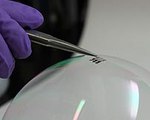Ultra-Thin Solar Cells Made in One-Step Process
 Feb-27-16
MIT researchers have used a novel fabrication method to create a proof-of-concept of the lightest and thinnest solar cells yet.
Feb-27-16
MIT researchers have used a novel fabrication method to create a proof-of-concept of the lightest and thinnest solar cells yet.Rather than manufacturing solar cells by building each layer separately, the MIT method makes the entire solar cell at one time, using the flexible polymer parylene for the substrate and coating, and dibutyl phthalate as the light-absorbing component. Established vapor deposition techniques are used to “grow” the substrate and the cell, and the single-step process occurs at room temperature in a vacuum chamber without the use of solvents (conventional solar cell manufacturing relies on chemicals and high temperatures).
The resulting cell was lightweight enough to sit atop a soap bubble without popping it, but the team admits such lightweight cells may be a bit impractical for real world use. However, the team believes the process can be scaled up, and the cells made a bit thicker.
More Info about this Invention:
[POPSCI.COM][NEWS.MIT.EDU]

Add Your Comment